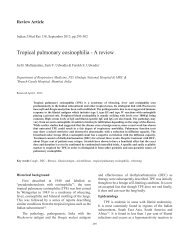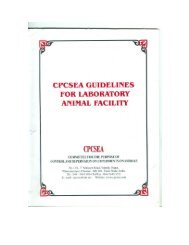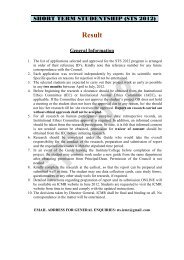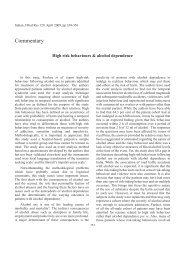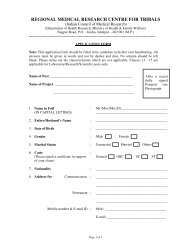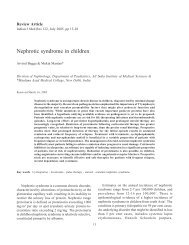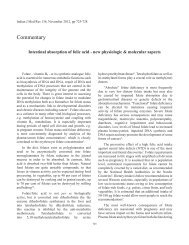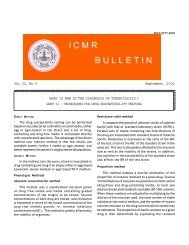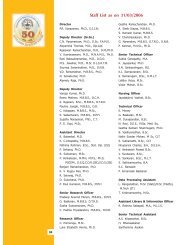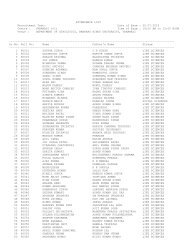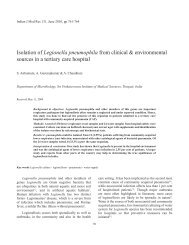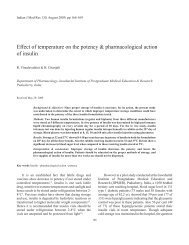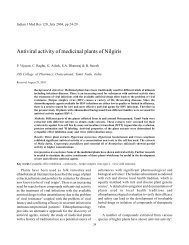Effects of heat stress on endocrine functions - Indian Council of ...
Effects of heat stress on endocrine functions - Indian Council of ...
Effects of heat stress on endocrine functions - Indian Council of ...
You also want an ePaper? Increase the reach of your titles
YUMPU automatically turns print PDFs into web optimized ePapers that Google loves.
<strong>Indian</strong> J Med Res 135, February 2012, pp 233-239<br />
<str<strong>on</strong>g>Effects</str<strong>on</strong>g> <str<strong>on</strong>g>of</str<strong>on</strong>g> <str<strong>on</strong>g>heat</str<strong>on</strong>g> <str<strong>on</strong>g>stress</str<strong>on</strong>g> <strong>on</strong> <strong>endocrine</strong> functi<strong>on</strong>s & behaviour<br />
in the pre-pubertal rat<br />
Fatih Mete *,** , Ertugrul Kilic * , Adnan Somay † & Bayram Yilmaz *<br />
*,** Yeditepe University, Faculty <str<strong>on</strong>g>of</str<strong>on</strong>g> Medicine, Department <str<strong>on</strong>g>of</str<strong>on</strong>g> Physiology & Vakif Gureba Educati<strong>on</strong><br />
& Research Hospital, Departments <str<strong>on</strong>g>of</str<strong>on</strong>g> ** Pediatrics & † Pathology, Istanbul, Turkey<br />
Received April 28, 2010<br />
Background & objectives: Heat <str<strong>on</strong>g>stress</str<strong>on</strong>g> related hyperthermia may cause damage to various organ systems.<br />
There are very few studies <strong>on</strong> the effects <str<strong>on</strong>g>of</str<strong>on</strong>g> hyperthermia <strong>on</strong> the <strong>endocrine</strong> system. We therefore,<br />
investigated effects <str<strong>on</strong>g>of</str<strong>on</strong>g> exogenously induced hyperthermia <strong>on</strong> adrenal, testicular and thyroid functi<strong>on</strong>s<br />
and behavioural alterati<strong>on</strong>s in pre-pubertal male Sprague-Dawley rats.<br />
Methods: Three groups <str<strong>on</strong>g>of</str<strong>on</strong>g> 30-day old rats (n=7 per group) were used. Body temperature was increased<br />
to 39°C (Group I) and 41°C (Group II) in a hyperthermia inducti<strong>on</strong> chamber for 30 min. The rats<br />
in the Group III served as c<strong>on</strong>trol (36 °C). All animals received saline and were decapitated 48 h<br />
after the experiments. Serum free triiodothyr<strong>on</strong>in (fT3), free thyroxine (fT4), total testoster<strong>on</strong>e and<br />
dehydroepiandroster<strong>on</strong>e sulphate (DHEA-S) levels were determined by chemiluminescence assay, and<br />
corticoster<strong>on</strong>e by enzyme immunoassay. Testes, pituitary and adrenal glands were dissected out and<br />
processed for histopathological examinati<strong>on</strong>. To assess activity and anxiety <str<strong>on</strong>g>of</str<strong>on</strong>g> the animals, the open field<br />
test and elevated-0-maze test, respectively, were used in all groups 24 h before (day 29) and after (day<br />
31) hyperthermia inducti<strong>on</strong>.<br />
Results: Serum corticoster<strong>on</strong>e levels (3.22±1.3) were significantly reduced in the 39°C (1.3±0.9) and 41°C<br />
(1.09±0.7) hyperthermia groups (P
234 INDIAN J MED RES, FEBRUARY 2012<br />
Hyperthermia may cause damage in various organs<br />
and systems in the body 2 . However, most <str<strong>on</strong>g>of</str<strong>on</strong>g> the studies<br />
investigating the adverse effects <str<strong>on</strong>g>of</str<strong>on</strong>g> hyperthermic<br />
c<strong>on</strong>diti<strong>on</strong>s have focused <strong>on</strong> the central nervous<br />
system 4 . Blood-brain barrier (BBB) permeability<br />
has been shown to be impaired by hyperthermia in<br />
experimental models 3,5 . Leakage <str<strong>on</strong>g>of</str<strong>on</strong>g> serum proteins<br />
within the brain micro-fluid envir<strong>on</strong>ment appears to<br />
be the main factor for brain oedema formati<strong>on</strong> 5 . Heatrelated<br />
neur<strong>on</strong>al degenerati<strong>on</strong> has also been reported 6 .<br />
It has been shown that hyperthermia increases apoptotic<br />
cell death, a c<strong>on</strong>diti<strong>on</strong> that is affected by durati<strong>on</strong> <str<strong>on</strong>g>of</str<strong>on</strong>g><br />
hyperthermia 6,7 . Thus, increased brain hyperthermia<br />
may cause neurotoxicity either directly or through<br />
disrupti<strong>on</strong> <str<strong>on</strong>g>of</str<strong>on</strong>g> BBB.<br />
Hyperthermia is <strong>on</strong>e <str<strong>on</strong>g>of</str<strong>on</strong>g> the most frequent causes<br />
<str<strong>on</strong>g>of</str<strong>on</strong>g> paediatric complaints leading to hospital admissi<strong>on</strong>.<br />
Infant and child brain is susceptible to hyperthermia<br />
and may undergo various pathological c<strong>on</strong>diti<strong>on</strong>s 8,9 .<br />
There are limited studies <strong>on</strong> <str<strong>on</strong>g>heat</str<strong>on</strong>g>-induced alterati<strong>on</strong>s<br />
in <strong>endocrine</strong> functi<strong>on</strong>s and behavioural dysfuncti<strong>on</strong>s,<br />
particularly in infants and children 3 . A few studies<br />
dem<strong>on</strong>strated adverse effects <str<strong>on</strong>g>of</str<strong>on</strong>g> hyperthermia <strong>on</strong><br />
the brain in rats 10-12 . Hyperthermia may impair<br />
cognitive functi<strong>on</strong>s 13 , induce problems in coping and<br />
behaviour 14 including motor functi<strong>on</strong>s 9 . Developing<br />
rats exposed to hyperthermia have been shown to<br />
display signs <str<strong>on</strong>g>of</str<strong>on</strong>g> increased anxiety in the elevatedplus<br />
maze, but these changes were not associated with<br />
increased susceptibility to depressi<strong>on</strong>-like behaviour 15 .<br />
Hyperthermia is an important <str<strong>on</strong>g>stress</str<strong>on</strong>g> factor and known<br />
to increase blood cortisol levels 16 . This is expected<br />
since hypothalamo-pituitary-adrenocortical (HPA)<br />
axis is activated in resp<strong>on</strong>se to <str<strong>on</strong>g>stress</str<strong>on</strong>g>ors such as <str<strong>on</strong>g>heat</str<strong>on</strong>g><br />
and inflammati<strong>on</strong> 17 . It has been reported that thyroid<br />
functi<strong>on</strong> may be altered by hyperthermic c<strong>on</strong>diti<strong>on</strong>s 18-19 .<br />
There are several reports indicating that increased<br />
temperature inhibits spermatogenesis 20,21 . However,<br />
post-hyperthermic effects <strong>on</strong> testicular functi<strong>on</strong>s have<br />
not been studied in pre-pubertal rats.<br />
In this study, we have examined effects <str<strong>on</strong>g>of</str<strong>on</strong>g> <str<strong>on</strong>g>heat</str<strong>on</strong>g><br />
exposure-induced hyperthermia <strong>on</strong> various <strong>endocrine</strong><br />
functi<strong>on</strong>s and behaviours in pre-pubertal male rats.<br />
Material & Methods<br />
The study was c<strong>on</strong>ducted in the Department <str<strong>on</strong>g>of</str<strong>on</strong>g><br />
Physiology, Yeditepe University, Istanbul, Turkey.<br />
Pre-pubertal (30-day old) male Sprague-Dawley<br />
rats were used in this study. The animals were<br />
obtained from Yeditepe University Medical School<br />
Experimental Research Center (YUDETAM) and<br />
housed at c<strong>on</strong>trolled room temperature (21±1 o C) with<br />
12:12 h light:dark cycle. Standard pellet diet and<br />
water were provided ad libitum. The rats were divided<br />
into three groups (n=7 per group). Body temperature<br />
was increased to 39°C (Group I) and 41°C (Group<br />
II) by <str<strong>on</strong>g>heat</str<strong>on</strong>g> exposure in a Hyperthermia Inducti<strong>on</strong><br />
Chamber for 30 min. The rats in the Group III served<br />
as c<strong>on</strong>trol (36 °C). The ambient temperature <str<strong>on</strong>g>of</str<strong>on</strong>g> the<br />
laboratory was maintained at 21°C. Hyperthermia<br />
Inducti<strong>on</strong> Chamber (a large plexyglass box: 40 x 40 x<br />
35 cm) was designed in our laboratory. A thermostatc<strong>on</strong>trolled<br />
<str<strong>on</strong>g>heat</str<strong>on</strong>g>er was fitted at the top-lid <str<strong>on</strong>g>of</str<strong>on</strong>g> the<br />
chamber and temperature was c<strong>on</strong>tinuously m<strong>on</strong>itored<br />
by a thermometer throughout the experiment. The<br />
animals in each group were placed and exposed to <str<strong>on</strong>g>heat</str<strong>on</strong>g><br />
<str<strong>on</strong>g>stress</str<strong>on</strong>g> together (n=7). Core temperature <str<strong>on</strong>g>of</str<strong>on</strong>g> the animals<br />
was m<strong>on</strong>itored by using a rectal thermistor attached<br />
to a Harvard Homeothermic System (Kent, UK),<br />
throughout the experiments. The body temperature<br />
was not allowed to exceed 39 and 41°C in the Groups<br />
I and II, respectively. The experiments were approved<br />
by the Yeditepe University Ethics Committee <strong>on</strong><br />
Experimental Animals.<br />
All animals were decapitated 48 h after the<br />
experiments (<strong>on</strong> the day 32) and trunk blood was<br />
collected. Blood samples were centrifuged (4°C, 670 g)<br />
Fig. 1. Animal activity scores (sec) in open field test in pre-pubertal<br />
male rats exposed to <str<strong>on</strong>g>heat</str<strong>on</strong>g> <str<strong>on</strong>g>stress</str<strong>on</strong>g> (39 o C and 41 o C hyperthermia) for<br />
30 min. * P
METE et al: EFFECTS OF HYPERTHERMIA ON ENDOCRINE FUNCTIONS IN RAT 235<br />
(a)<br />
(c)<br />
for 10 min, and serum was separated and stored at -20<br />
o C until assayed. Serum free triiodothyr<strong>on</strong>ine (fT3),<br />
free thyroxine (fT4), dehydroepiandroster<strong>on</strong>e sulphate<br />
(DHEA-S) and total testoster<strong>on</strong>e (TTE) levels were<br />
determined by chemiluminescence assay (Roche<br />
Diagnostics, France) using Modular E170 analyzer.<br />
Serum corticoster<strong>on</strong>e levels were determined by<br />
enzyme immunoassay (IDS Ltd, Bold<strong>on</strong> UK) 22 . Testes,<br />
pituitary and adrenal glands were dissected out, fixed<br />
in 10 per cent formalin (buffered with pH 7.2) soluti<strong>on</strong><br />
and processed for histopathological examinati<strong>on</strong>.<br />
(b)<br />
Fig. 3 a. Adrenal cortex <str<strong>on</strong>g>of</str<strong>on</strong>g> the c<strong>on</strong>trol rats. HE X 200. b. Mild<br />
hydropic swelling in the adrenal cortex <str<strong>on</strong>g>of</str<strong>on</strong>g> the 39 o C hyperthermia<br />
group male rats. HE X 400. c. Mild hydropic degenerati<strong>on</strong> in the<br />
adrenal cortex <str<strong>on</strong>g>of</str<strong>on</strong>g> the 41 o C hyperthermia group male rats. HE X<br />
400.<br />
To assess the activity and anxiety <str<strong>on</strong>g>of</str<strong>on</strong>g> the animals,<br />
the open field test 23 and elevated-0-maze test 23 ,<br />
respectively, were used in all groups 24 h before (<strong>on</strong><br />
the day 29) and after (<strong>on</strong> the day 31) hyperthermia<br />
inducti<strong>on</strong>. These behavioural tests were performed in<br />
a blinded fashi<strong>on</strong> 23 .<br />
Open field test: This test was used to detect sp<strong>on</strong>taneous<br />
locomotor activity and explorati<strong>on</strong> behaviour. The<br />
open field c<strong>on</strong>sists <str<strong>on</strong>g>of</str<strong>on</strong>g> a round arena (diameter: 150 cm)<br />
covered by a white plastic floor, surrounded by a 35cm<br />
high sidewall made <str<strong>on</strong>g>of</str<strong>on</strong>g> white polypropylene. Each<br />
rat was placed in a corner <str<strong>on</strong>g>of</str<strong>on</strong>g> the field and its behaviour<br />
(moving or staying in the same area) recorded for 10<br />
min. Testing was carried out in a temperature, noise<br />
and light c<strong>on</strong>trolled room.<br />
Table. Serum free triiodothyr<strong>on</strong>ine (fT3), free thyroxine (fT4), dehydroepiandroster<strong>on</strong>e sulfate (DHEA-S), total testoster<strong>on</strong>e (TTE) and<br />
corticoster<strong>on</strong>e levels in pre-pubertal male rats exposed to <str<strong>on</strong>g>heat</str<strong>on</strong>g> <str<strong>on</strong>g>stress</str<strong>on</strong>g> (39 o C and 41 o C hyperthermia) for 30 min<br />
Groups Corticoster<strong>on</strong>e<br />
(µg/dl)<br />
fT3<br />
(pg/ml)<br />
fT4<br />
(ng/ml)<br />
TTE<br />
(ng/dl)<br />
DHEA-S<br />
(µg/dl)<br />
C<strong>on</strong>trol 3.22±1.3 4,38 ± 0,42 2,35 ± 0,12
236 INDIAN J MED RES, FEBRUARY 2012<br />
Elevated O maze: The elevated O maze c<strong>on</strong>sists <str<strong>on</strong>g>of</str<strong>on</strong>g> a<br />
round 5.5 cm wide polyvinyl-chloride runway with an<br />
outer diameter <str<strong>on</strong>g>of</str<strong>on</strong>g> 46 cm, which is placed 40 cm above<br />
the floor and which detects sp<strong>on</strong>taneous locomotor<br />
behaviour and correlates <str<strong>on</strong>g>of</str<strong>on</strong>g> fear and anxiety 24 . Two<br />
opposing 90° sectors are protected by 16 cm high<br />
inner and outer walls made <str<strong>on</strong>g>of</str<strong>on</strong>g> polyvinyl-chloride<br />
(closed sectors). The remaining two 90° sectors are<br />
not protected by walls (open sectors). Animals were<br />
released in <strong>on</strong>e <str<strong>on</strong>g>of</str<strong>on</strong>g> the closed sectors and observed for<br />
10 min. The total number <str<strong>on</strong>g>of</str<strong>on</strong>g> z<strong>on</strong>e entries - as correlate<br />
<str<strong>on</strong>g>of</str<strong>on</strong>g> motor activity - and the time spent in the unprotected<br />
sector - as correlate <str<strong>on</strong>g>of</str<strong>on</strong>g> explorati<strong>on</strong> behaviour, fear and<br />
anxiety - were registered whenever the animal moved<br />
into a sector with all four paws.<br />
Results (Mean ± SD) were statistically analyzed by<br />
using <strong>on</strong>e-way analysis <str<strong>on</strong>g>of</str<strong>on</strong>g> variance followed by LSD<br />
test. P
METE et al: EFFECTS OF HYPERTHERMIA ON ENDOCRINE FUNCTIONS IN RAT 237<br />
Discussi<strong>on</strong><br />
(a)<br />
(c)<br />
Fig. 5 a. Normal maturati<strong>on</strong> <str<strong>on</strong>g>of</str<strong>on</strong>g> germ cells in the seminiferous tubules in the c<strong>on</strong>trol group. HE X 200. b. Hydropic swelling in germ cells in<br />
the seminiferous tubules <str<strong>on</strong>g>of</str<strong>on</strong>g> pre-pubertal male rats exposed to 39 o C hyperthermia. HE X 400.c. Presence <str<strong>on</strong>g>of</str<strong>on</strong>g> apoptotic germ cells (arrow) in<br />
the seminiferous tubules <str<strong>on</strong>g>of</str<strong>on</strong>g> pre-pubertal male rats exposed to 41 o C hyperthermia. HE X 400. d. Presence <str<strong>on</strong>g>of</str<strong>on</strong>g> apoptotic germ cells (arrow) in<br />
the seminiferous tubules <str<strong>on</strong>g>of</str<strong>on</strong>g> pre-pubertal male rats exposed to 41 o C hyperthermia. HE X 400.<br />
It is known that HPA axis is activated in resp<strong>on</strong>se<br />
to various types <str<strong>on</strong>g>of</str<strong>on</strong>g> <str<strong>on</strong>g>stress</str<strong>on</strong>g> including <str<strong>on</strong>g>heat</str<strong>on</strong>g> 15,25 . Acute<br />
increases in plasma cortisol levels have been<br />
correlated with coping behaviour and adaptati<strong>on</strong> to<br />
<str<strong>on</strong>g>heat</str<strong>on</strong>g> <str<strong>on</strong>g>stress</str<strong>on</strong>g> 26 . Rats with impaired HPA axis were less<br />
tolerant to <str<strong>on</strong>g>heat</str<strong>on</strong>g> <str<strong>on</strong>g>stress</str<strong>on</strong>g> exposure 15 . In our study, serum<br />
levels <str<strong>on</strong>g>of</str<strong>on</strong>g> corticoster<strong>on</strong>e were significantly lower than<br />
the c<strong>on</strong>trol group. Since the animals were decapitated<br />
48 h after the hyperthermic <str<strong>on</strong>g>stress</str<strong>on</strong>g> inducti<strong>on</strong>, reduced<br />
corticoster<strong>on</strong>e may be attributed to post-<str<strong>on</strong>g>stress</str<strong>on</strong>g> changes,<br />
like in post-traumatic <str<strong>on</strong>g>stress</str<strong>on</strong>g> disorder (PTSD). PTSD is<br />
an anxiety disorder that can develop after exposure to<br />
a traumatic event 27 . Previously, plasma corticoster<strong>on</strong>e<br />
and adrenocorticotropic horm<strong>on</strong>e (ACTH) levels<br />
were found to be low in <str<strong>on</strong>g>heat</str<strong>on</strong>g> exhausted rats 14 . In the<br />
present study, anxiety scores <str<strong>on</strong>g>of</str<strong>on</strong>g> the animals in the<br />
(b)<br />
(d)<br />
hyperthermia groups were associated with decreased<br />
corticoster<strong>on</strong>e levels. Hyperthermia-related anxiety<br />
has been shown in developing rats 28 . Our findings<br />
show such anxiety behaviour in the elevated-0-maze<br />
two days after exposure to the <str<strong>on</strong>g>heat</str<strong>on</strong>g> <str<strong>on</strong>g>stress</str<strong>on</strong>g>. Activity <str<strong>on</strong>g>of</str<strong>on</strong>g><br />
the <str<strong>on</strong>g>heat</str<strong>on</strong>g>-exposed rats (as determined by using open<br />
field test) was also found to be decreased. Depressi<strong>on</strong>like<br />
behaviour has previously been reported in the<br />
immature rat 28,29 . Thus, our findings provide further<br />
evidence that hypocorticoster<strong>on</strong>aemia is associated<br />
with behavioural deficits in pre-pubertal male rats.<br />
DHEA-S has been associated with adaptati<strong>on</strong> against<br />
external <str<strong>on</strong>g>stress</str<strong>on</strong>g> 31 . Decrease in DHEA-S c<strong>on</strong>centrati<strong>on</strong>s<br />
was reported in male subjects undergoing hot spring<br />
immersi<strong>on</strong> (41 o C) for 30 min 14 . In our study, adrenal<br />
androgen levels were below the limit <str<strong>on</strong>g>of</str<strong>on</strong>g> detecti<strong>on</strong><br />
suggesting that <strong>on</strong>ly corticoster<strong>on</strong>e secreti<strong>on</strong> <str<strong>on</strong>g>of</str<strong>on</strong>g> the
238 INDIAN J MED RES, FEBRUARY 2012<br />
adrenal cortex was affected by 30-min <str<strong>on</strong>g>heat</str<strong>on</strong>g> <str<strong>on</strong>g>stress</str<strong>on</strong>g> in<br />
pre-pubertal rats.<br />
It has been reported that exposure to hyperthermia<br />
during pregnancy caused marked growth retardati<strong>on</strong><br />
<str<strong>on</strong>g>of</str<strong>on</strong>g> the adrenal cortex and a decreased populati<strong>on</strong><br />
<str<strong>on</strong>g>of</str<strong>on</strong>g> somatotropes in the adenohypophysis in the <str<strong>on</strong>g>of</str<strong>on</strong>g>fsprings<br />
31 . Immunoreactivity for ACTH in the pituitary<br />
gland <str<strong>on</strong>g>of</str<strong>on</strong>g> these animals was not significantly altered<br />
by hyperthermia. In our study, hyperthermia in 30-<br />
day old rats resulted in mild hydropic swelling and<br />
degenerati<strong>on</strong>, respectively, in the adrenal cortex.<br />
Corticoster<strong>on</strong>e secreti<strong>on</strong> was significantly decreased in<br />
both groups 48 h after the <str<strong>on</strong>g>heat</str<strong>on</strong>g> <str<strong>on</strong>g>stress</str<strong>on</strong>g> exposure. It is<br />
possible that hyperthermia suppressed the functi<strong>on</strong> <str<strong>on</strong>g>of</str<strong>on</strong>g><br />
the adrenal glands without remarkable change <str<strong>on</strong>g>of</str<strong>on</strong>g> their<br />
morphology. A recent study has shown that increased<br />
temperature decreases binding affinity <str<strong>on</strong>g>of</str<strong>on</strong>g> cortisol<br />
to plasma proteins 32 . Heat <str<strong>on</strong>g>stress</str<strong>on</strong>g>-related changes in<br />
glucocorticoid horm<strong>on</strong>e levels may also be attributed<br />
to percentage <str<strong>on</strong>g>of</str<strong>on</strong>g> binding to the carriers rather than a<br />
change in secreti<strong>on</strong> pattern.<br />
In another study, rabbits were exposed to <str<strong>on</strong>g>heat</str<strong>on</strong>g> in<br />
a chamber similar to ours and the rectal temperature<br />
was m<strong>on</strong>itored 18 and acute hyperthermia resulted in<br />
reduced blood flow to the thyroid gland and decreased<br />
secreti<strong>on</strong> <str<strong>on</strong>g>of</str<strong>on</strong>g> fT3 and fT4. In the present study, serum<br />
levels <str<strong>on</strong>g>of</str<strong>on</strong>g> thyroid horm<strong>on</strong>es did not significantly differ<br />
compared to the c<strong>on</strong>trol values as measured 48 h after<br />
<str<strong>on</strong>g>heat</str<strong>on</strong>g> exposure. Thus, it appears that hyperthermia<br />
causes a transient decrease in thyroid gland functi<strong>on</strong>.<br />
Immunoreactivity <str<strong>on</strong>g>of</str<strong>on</strong>g> the thyroid stimulating horm<strong>on</strong>e<br />
in the pituitary gland <str<strong>on</strong>g>of</str<strong>on</strong>g> <str<strong>on</strong>g>heat</str<strong>on</strong>g> exposed foetuses was not<br />
significantly different from that <str<strong>on</strong>g>of</str<strong>on</strong>g> c<strong>on</strong>trol specimens 31 .<br />
In our study, histopathology revealed hyperemia in<br />
the group I (39 o C) and hydropic degenerati<strong>on</strong> and<br />
focal necrosis in the group II (41 o C). It appears that<br />
either these changes did not affect secreti<strong>on</strong> pattern<br />
<str<strong>on</strong>g>of</str<strong>on</strong>g> pituitary-thyroid axis or any acute alterati<strong>on</strong> in<br />
thyroid horm<strong>on</strong>e secreti<strong>on</strong> pattern was not sustained<br />
until 48 h after <str<strong>on</strong>g>heat</str<strong>on</strong>g> <str<strong>on</strong>g>stress</str<strong>on</strong>g> exposure.<br />
Testicular functi<strong>on</strong> is highly dependent <strong>on</strong><br />
temperature c<strong>on</strong>trol and negatively influenced by<br />
hyperthermia 20 . L<strong>on</strong>g-term applicati<strong>on</strong> <str<strong>on</strong>g>of</str<strong>on</strong>g> mild testicular<br />
hyperthermia induces stage-specific and germ cellspecific<br />
apoptosis in adult m<strong>on</strong>key testes 33 . Similarly,<br />
exposure to <str<strong>on</strong>g>heat</str<strong>on</strong>g> for short period has been shown to<br />
trigger apoptosis in dividing cell populati<strong>on</strong>s in the<br />
testis 21 . In our study, inducti<strong>on</strong> <str<strong>on</strong>g>of</str<strong>on</strong>g> 41 o C hyperthermia for<br />
30 min in pre-pubertal rats has also caused pathological<br />
changes in sperm cells. Biochemical analysis revealed<br />
that serum TTE levels were below the limit <str<strong>on</strong>g>of</str<strong>on</strong>g> detecti<strong>on</strong><br />
(
METE et al: EFFECTS OF HYPERTHERMIA ON ENDOCRINE FUNCTIONS IN RAT 239<br />
13. Gaoua N, Racinais S, Grantham J, El Massioui F. Alterati<strong>on</strong>s<br />
in cognitive performance during passive hyperthermia are<br />
task dependent. Int J Hyperthermia 2011; 27 : 1-9.<br />
14. Wang JS, Chen SM, Lee SP, Lee SD, Huang CY, Hsieh CC,<br />
et al. Dehydroepiandroster<strong>on</strong>e sulfate linked to physiologic<br />
resp<strong>on</strong>se against hot spring immersi<strong>on</strong>. Steroids 2009; 74 :<br />
945-9.<br />
15. Michel V, Peinnequin A, Al<strong>on</strong>so A, Buguet A, Cespuglio<br />
R, Canini F. Decreased <str<strong>on</strong>g>heat</str<strong>on</strong>g> tolerance is associated with<br />
hypothalamo-pituitary-adrenocortical axis impairment.<br />
Neuroscience 2007; 147 : 522-31.<br />
16. Wright HE, Selkirk GA, McLellan TM. HPA and SAS resp<strong>on</strong>ses<br />
to increasing core temperature during uncompensable<br />
exerti<strong>on</strong>al <str<strong>on</strong>g>heat</str<strong>on</strong>g> <str<strong>on</strong>g>stress</str<strong>on</strong>g> in trained and untrained males. Eur J<br />
Appl Physiol 2010; 108 : 987-97.<br />
17. Schobitz B, Reul JM, Holsboer F. The role <str<strong>on</strong>g>of</str<strong>on</strong>g> the hypothalamicpituitary-adrenocortical<br />
system during inflammatory<br />
c<strong>on</strong>diti<strong>on</strong>s. Crit Rev Neurobiol 1994; 8 : 263-91.<br />
18. Mustafa S, Al-Bader MD, Elgazzar AH, Alshammeri J,<br />
Gopinath S, Essam H. Effect <str<strong>on</strong>g>of</str<strong>on</strong>g> hyperthermia <strong>on</strong> the functi<strong>on</strong><br />
<str<strong>on</strong>g>of</str<strong>on</strong>g> thyroid gland. Eur J Appl Physiol 2008; 103 : 285-8.<br />
19. Sprague JE, Banks ML, Cook VJ, Mills EM. Hypothalamicpituitary-thyroid<br />
axis and sympathetic nervous<br />
system involvement in hyperthermia induced by 3,4<br />
methylenedioxymethamphetamine (Ecstasy). J Pharmacol<br />
Exp Ther 2003; 305 : 159-66.<br />
20. Jung A, Schuppe HC. Influence <str<strong>on</strong>g>of</str<strong>on</strong>g> genital <str<strong>on</strong>g>heat</str<strong>on</strong>g> <str<strong>on</strong>g>stress</str<strong>on</strong>g> <strong>on</strong> semen<br />
quality in humans. Andrologia 2007; 39: 203-15.<br />
21. Khan VR, Brown IR. The effect <str<strong>on</strong>g>of</str<strong>on</strong>g> hyperthermia <strong>on</strong> the<br />
inducti<strong>on</strong> <str<strong>on</strong>g>of</str<strong>on</strong>g> cell death in brain, testis, and thymus <str<strong>on</strong>g>of</str<strong>on</strong>g> the adult<br />
and developing rat. Cell Stress Chaper<strong>on</strong>es 2002; 7 : 73-90.<br />
22. Levay EA, Paolini AG, Govic A, Hazi A, Penman J, Kent S.<br />
HPA and sympathoadrenal activity <str<strong>on</strong>g>of</str<strong>on</strong>g> adult rats perinatally<br />
exposed to maternal mild calorie restricti<strong>on</strong>. Behav Brain Res<br />
2010; 208 : 202-8.<br />
23. Kilic E, Kilic U, Bacigaluppi M, Guo Z, Abdallah NB, Wolfer<br />
DP, et al. Delayed melat<strong>on</strong>in administrati<strong>on</strong> promotes neur<strong>on</strong>al<br />
survival, neurogenesis and motor recovery, and attenuates<br />
hyperactivity and anxiety after mild focal cerebral ischemia in<br />
mice. J Pineal Res 2008; 45 : 142-8.<br />
24. Belzung C, Griebel G. Measuring normal and pathological<br />
anxiety-like behaviour in mice: a review. Behav Brain Res<br />
2001; 125 : 141-9.<br />
25. Paris JJ, Franco C, Sodano R, Freidenberg B, Gordis E,<br />
Anders<strong>on</strong> DA, et al. Sex differences in salivary cortisol in<br />
resp<strong>on</strong>se to acute <str<strong>on</strong>g>stress</str<strong>on</strong>g>ors am<strong>on</strong>g healthy participants, in<br />
recreati<strong>on</strong>al or pathological gamblers, and in those with<br />
posttraumatic <str<strong>on</strong>g>stress</str<strong>on</strong>g> disorder. Horm Behav 2010; 57 : 35-45.<br />
26. Judels<strong>on</strong> DA, Maresh CM, Yamamoto LM, Farrell MJ,<br />
Armstr<strong>on</strong>g LE, Kraemer WJ, et al. Effect <str<strong>on</strong>g>of</str<strong>on</strong>g> hydrati<strong>on</strong> state <strong>on</strong><br />
resistance exercise-induced <strong>endocrine</strong> markers <str<strong>on</strong>g>of</str<strong>on</strong>g> anabolism,<br />
catabolism, and metabolism. J Appl Physiol 2008; 105 : 816-<br />
24.<br />
27. Pervanidou P, Chrousos GP. Neuroendocrinology <str<strong>on</strong>g>of</str<strong>on</strong>g> posttraumatic<br />
<str<strong>on</strong>g>stress</str<strong>on</strong>g> disorder. Prog Brain Res 2010; 182 : 149-60.<br />
28. Kilic EZ, Kilic C, Yilmaz S. Is anxiety sensitivity a predictor<br />
<str<strong>on</strong>g>of</str<strong>on</strong>g> PTSD in children and adolescents? J Psychosom Res 2008;<br />
65 : 81-6.<br />
29. Mesquita AR, Tavares HB, Silva R, Sousa N. Febrile<br />
c<strong>on</strong>vulsi<strong>on</strong>s in developing rats induce a hyperanxious<br />
phenotype later in life. Epilepsy Behav 2006; 9 : 401-6.<br />
30. Yehuda R, Brand SR, Golier JA, Yang RK. Clinical correlates<br />
<str<strong>on</strong>g>of</str<strong>on</strong>g> DHEA associated with post-traumatic <str<strong>on</strong>g>stress</str<strong>on</strong>g> disorder. Acta<br />
Psychiatr Scand 2006; 114 : 187-93.<br />
31. Watanabe YG. Immunohistochemical study <strong>on</strong> the fetal rat<br />
pituitary in hyperthermia-induced exencephaly. Zoolog Sci<br />
2002; 19 : 689-94.<br />
32. Camer<strong>on</strong> A, Henley D, Carrell R, Zhou A, Clarke A, Lightman<br />
S. Temperature-resp<strong>on</strong>sive release <str<strong>on</strong>g>of</str<strong>on</strong>g> cortisol from its binding<br />
globulin: a protein thermocouple. J Clin Endocrinol Metab<br />
2010; 95 : 4689-95.<br />
33. Lue YH, Lasley BL, Laughlin LS, Swerdl<str<strong>on</strong>g>of</str<strong>on</strong>g>f RS, Hikim AP,<br />
Leung A, et al. Mild testicular hyperthermia induces pr<str<strong>on</strong>g>of</str<strong>on</strong>g>ound<br />
transiti<strong>on</strong>al spermatogenic suppressi<strong>on</strong> through increased<br />
germ cell apoptosis in adult cynomolgus m<strong>on</strong>keys (Macaca<br />
fascicularis). J Androl 2002; 23 : 799-805.<br />
34. Lue YH, Hikim AP, Swerdl<str<strong>on</strong>g>of</str<strong>on</strong>g>f RS, Im P, Taing KS, Bui T, et<br />
al. Single exposure to <str<strong>on</strong>g>heat</str<strong>on</strong>g> induces stage-specific germ cell<br />
apoptosis in rats: role <str<strong>on</strong>g>of</str<strong>on</strong>g> intratesticular testoster<strong>on</strong>e <strong>on</strong> stage<br />
specificity. Endocrinology 1999; 140 : 1709-17.<br />
Reprint requests: Pr<str<strong>on</strong>g>of</str<strong>on</strong>g>. Dr Bayram Yilmaz, Yeditepe University, Faculty <str<strong>on</strong>g>of</str<strong>on</strong>g> Medicine, Department <str<strong>on</strong>g>of</str<strong>on</strong>g> Physiology, 34755, Istanbul, Turkey<br />
e-mail: bayram2353@yahoo.com



